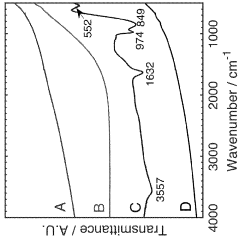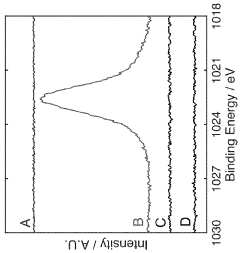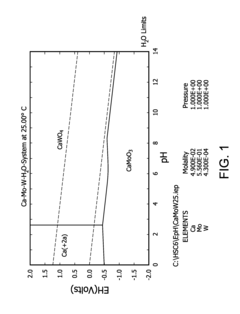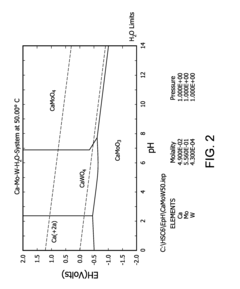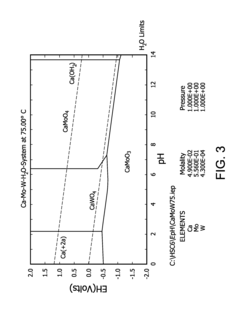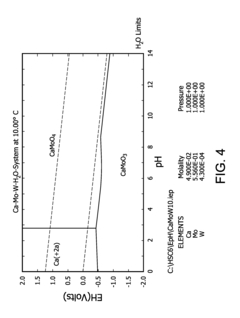Tungsten In The Realm Of High-Energy Physics
Tungsten in HEP: Background and Objectives
Tungsten has played a pivotal role in the field of high-energy physics (HEP) for decades, serving as a crucial material in various experimental setups and detector systems. The evolution of tungsten's applications in HEP has been closely tied to the advancements in particle accelerators and detection technologies. From its initial use in target materials to its current applications in calorimeters and shielding, tungsten has consistently demonstrated its value in pushing the boundaries of our understanding of fundamental particles and their interactions.
The primary objective of utilizing tungsten in HEP is to leverage its unique physical properties to enhance the performance and efficiency of particle detection and measurement systems. Tungsten's high density, excellent thermal conductivity, and resistance to radiation damage make it an ideal candidate for various components in high-energy particle experiments. As researchers continue to explore higher energy regimes and more precise measurements, the demand for materials that can withstand extreme conditions while providing accurate data has intensified.
One of the key trends in tungsten's application in HEP is the development of advanced tungsten-based composites and alloys. These materials aim to combine tungsten's desirable properties with those of other elements to create optimized solutions for specific experimental requirements. For instance, tungsten-copper composites have gained attention for their improved thermal management capabilities in high-radiation environments.
Another significant trend is the miniaturization and increased precision of tungsten components in detector systems. As particle physics experiments become more sophisticated, there is a growing need for finer granularity in calorimeters and tracking devices. This has led to the development of novel fabrication techniques for tungsten, such as 3D printing and advanced machining processes, enabling the creation of complex geometries and micro-structures.
The future direction of tungsten research in HEP is likely to focus on enhancing its performance under extreme conditions, such as those encountered in next-generation particle accelerators. This includes improving tungsten's resistance to radiation-induced damage, optimizing its thermal management properties, and developing new tungsten-based materials with tailored characteristics for specific experimental setups.
As the field of HEP continues to evolve, the role of tungsten is expected to expand further. Ongoing research aims to explore its potential in neutrino physics experiments, dark matter detection, and other frontier areas of particle physics. The continuous improvement of tungsten-based technologies is crucial for enabling breakthroughs in our understanding of the fundamental laws of nature and pushing the boundaries of experimental physics.
Market Demand for Tungsten in HEP Applications
The market demand for tungsten in high-energy physics (HEP) applications has been steadily growing, driven by the increasing complexity and scale of particle accelerators and detectors. Tungsten's unique properties, including its high density, high melting point, and excellent radiation shielding capabilities, make it an indispensable material in various HEP experiments and facilities.
In particle accelerators, tungsten is widely used in beam collimators and targets. The demand for these components has risen as new accelerator facilities are constructed and existing ones are upgraded. For instance, the Large Hadron Collider (LHC) at CERN utilizes tungsten collimators to protect sensitive equipment from stray particles, and its planned upgrades will require additional tungsten components.
Tungsten's role in particle detectors is equally crucial. Calorimeters, which measure the energy of particles, often incorporate tungsten as an absorber material. The increasing precision requirements of HEP experiments have led to a growing demand for high-purity tungsten in these applications. Additionally, tungsten is used in electromagnetic and hadronic shower detectors, further expanding its market in the HEP sector.
The neutrino physics field has also contributed to the rising demand for tungsten. Neutrino detectors, such as those used in the Deep Underground Neutrino Experiment (DUNE), require large quantities of tungsten for their target systems. As neutrino research continues to advance, the demand for tungsten in this area is expected to grow.
Radiation shielding is another significant application driving the market demand for tungsten in HEP. As experiments become more powerful and intense, the need for effective shielding materials increases. Tungsten's high atomic number and density make it an excellent choice for protecting sensitive equipment and personnel from harmful radiation.
The global market for tungsten in HEP applications is closely tied to the funding and development of major research facilities. Government investments in scientific infrastructure, particularly in countries with advanced particle physics programs, directly impact the demand for tungsten. For example, the European Strategy for Particle Physics and similar initiatives in the United States, China, and Japan are expected to drive long-term demand for tungsten in HEP applications.
While the HEP sector represents a specialized market for tungsten, it is characterized by high-value, high-purity requirements. This demand often translates to premium pricing for tungsten products tailored to HEP applications. The market also benefits from the long-term nature of HEP projects, which can provide stable demand over extended periods.
Current Challenges in Tungsten Usage for HEP
Despite tungsten's remarkable properties that make it an ideal material for high-energy physics (HEP) applications, several significant challenges persist in its usage within this field. These challenges span across various aspects, from material properties to manufacturing processes and operational considerations.
One of the primary challenges is the inherent brittleness of tungsten, which can lead to structural failures under extreme conditions often encountered in HEP experiments. This brittleness becomes particularly problematic when tungsten components are subjected to rapid temperature changes or high-energy particle bombardment, potentially resulting in cracking or fragmentation. Addressing this issue requires innovative approaches in material science and engineering to enhance tungsten's ductility without compromising its other desirable properties.
Another significant challenge lies in the manufacturing and shaping of tungsten components for HEP applications. Due to its high melting point and hardness, traditional machining techniques often prove inadequate or extremely time-consuming when working with tungsten. This limitation hampers the production of complex geometries and precise components required for advanced HEP experiments. Developing new manufacturing methods, such as advanced powder metallurgy techniques or additive manufacturing processes tailored for tungsten, is crucial to overcome these production hurdles.
The activation of tungsten under high-energy particle bombardment poses yet another challenge. When exposed to intense radiation in HEP environments, tungsten can become radioactive, leading to safety concerns and complicating maintenance and disposal procedures. This activation not only affects the operational lifetime of tungsten components but also necessitates careful handling and specialized disposal methods, adding complexity to experimental setups and increasing overall costs.
Heat management presents a formidable challenge in tungsten usage for HEP. While tungsten's high thermal conductivity is generally advantageous, managing the extreme heat loads generated in certain HEP applications, such as in particle beam targets or collimators, remains problematic. Developing effective cooling strategies and designing components that can withstand and efficiently dissipate enormous heat fluxes is critical for the reliable operation of HEP equipment.
Lastly, the integration of tungsten with other materials in composite structures or layered designs presents ongoing challenges. Creating effective bonding techniques between tungsten and dissimilar materials, while maintaining structural integrity under extreme conditions, is essential for many HEP applications. This challenge extends to the development of coatings or surface treatments that can enhance tungsten's performance or mitigate some of its limitations without compromising its core properties.
Existing Tungsten Solutions in HEP Research
01 Tungsten deposition methods
Various methods for depositing tungsten on substrates, including chemical vapor deposition (CVD) and atomic layer deposition (ALD). These techniques are used to create thin films of tungsten for applications in semiconductor manufacturing and other industries.- Tungsten deposition and film formation: Various methods and processes for depositing tungsten and forming tungsten films on substrates. This includes techniques such as chemical vapor deposition (CVD), atomic layer deposition (ALD), and physical vapor deposition (PVD) to create thin, uniform tungsten layers for semiconductor applications.
- Tungsten etching and patterning: Techniques for etching and patterning tungsten layers in semiconductor manufacturing. This includes selective etching processes, plasma etching, and methods to create precise tungsten structures for various electronic components and interconnects.
- Tungsten alloys and composites: Development and production of tungsten alloys and composite materials. These materials combine tungsten with other elements or compounds to enhance specific properties such as strength, conductivity, or thermal resistance for use in various industrial applications.
- Tungsten in semiconductor devices: Applications of tungsten in semiconductor devices, including its use in interconnects, gate electrodes, and contact plugs. This covers the integration of tungsten in various semiconductor manufacturing processes and its role in improving device performance and reliability.
- Tungsten powder production and processing: Methods for producing and processing tungsten powder, including techniques for refining, shaping, and sintering tungsten particles. This encompasses various approaches to create high-quality tungsten powder for use in additive manufacturing, powder metallurgy, and other industrial applications.
02 Tungsten-based alloys and composites
Development of tungsten-based alloys and composite materials with enhanced properties such as improved strength, hardness, and thermal stability. These materials find applications in aerospace, defense, and high-temperature industrial processes.Expand Specific Solutions03 Tungsten etching and patterning
Techniques for etching and patterning tungsten layers in microelectronics fabrication. This includes selective etching processes, plasma etching, and methods to create fine tungsten structures for advanced semiconductor devices.Expand Specific Solutions04 Tungsten in lighting applications
Use of tungsten in lighting applications, particularly in filaments for incandescent and halogen lamps. This includes innovations in tungsten wire production, coatings to improve filament life, and novel lamp designs.Expand Specific Solutions05 Tungsten recycling and recovery
Methods for recycling and recovering tungsten from scrap materials and industrial waste. These processes aim to reduce the environmental impact of tungsten production and conserve this valuable resource.Expand Specific Solutions
Key Players in Tungsten Production for HEP
The field of high-energy physics utilizing tungsten is in a mature stage, with ongoing research and development. The market size is substantial, driven by applications in particle accelerators and detectors. Technologically, it's well-established but continually evolving. Key players like California Institute of Technology, Centre National de la Recherche Scientifique, and National Technology & Engineering Solutions of Sandia LLC are at the forefront of innovation. Universities such as Xi'an Jiaotong University and Swiss Federal Institute of Technology contribute significantly to research. Companies like General Electric Company and Toshiba Corp. are leveraging tungsten's properties for advanced applications. The competitive landscape is characterized by a mix of academic institutions, national laboratories, and industrial giants, each pushing the boundaries of tungsten's capabilities in high-energy physics.
California Institute of Technology
Centre National de la Recherche Scientifique
Core Innovations in Tungsten for HEP Applications
- An electroless process involving a sacrificial zinc coating and galvanic exchange in an ethereal solution of tungsten hexachloride (WCl6), followed by thermal treatment, allows for the spontaneous deposition of crystalline metallic tungsten on substrates like carbon foam electrodes.
- A process involving the dissolution of technical grade molybdenum trioxide in an aqueous ammonium hydroxide solution, followed by the addition of calcium, iron, or manganese compounds to generate a tungsten-containing precipitate, allowing for selective separation of tungsten from molybdenum.
Radiation Safety and Shielding Considerations
In the realm of high-energy physics, radiation safety and shielding considerations are paramount when working with tungsten. The high density and atomic number of tungsten make it an excellent material for radiation shielding, particularly against gamma rays and neutrons. However, its use in high-energy physics experiments also presents unique challenges that must be carefully addressed.
Tungsten's effectiveness as a radiation shield is due to its ability to attenuate high-energy particles and photons. When used in accelerator facilities, tungsten components can significantly reduce the radiation exposure of personnel and sensitive equipment. This is particularly important in areas surrounding beam lines, target stations, and detector systems where intense radiation fields are present.
Despite its shielding properties, tungsten itself can become activated when exposed to high-energy particles. This induced radioactivity must be taken into account when designing experimental setups and planning maintenance procedures. Proper handling and disposal protocols for activated tungsten components are essential to minimize radiation exposure to workers and the environment.
The design of tungsten shielding systems in high-energy physics experiments requires careful optimization. Factors such as the energy spectrum of the radiation, the geometry of the experimental setup, and the required level of attenuation must be considered. Monte Carlo simulations and advanced modeling techniques are often employed to predict the performance of tungsten shielding configurations and identify potential weak points.
In addition to its use as a passive shield, tungsten is also utilized in active shielding systems. These may include movable tungsten collimators or beam dumps that can be adjusted to control radiation levels in different experimental configurations. Such systems require precise control mechanisms and robust safety interlocks to prevent accidental exposure.
The integration of tungsten shielding with other materials, such as concrete or lead, is often necessary to achieve comprehensive radiation protection. Layered shielding designs can exploit the complementary properties of different materials to provide effective attenuation across a wide range of radiation types and energies.
Monitoring and dosimetry systems play a crucial role in ensuring the effectiveness of tungsten-based radiation shielding. Regular surveys and personal dosimetry for workers are essential to verify that radiation levels remain within acceptable limits and to detect any unexpected radiation leakage or activation issues.
Environmental Impact of Tungsten in HEP
The use of tungsten in high-energy physics (HEP) experiments has raised concerns about its environmental impact. Tungsten, while essential for various applications in particle accelerators and detectors, poses potential risks to ecosystems and human health if not properly managed.
One of the primary environmental concerns is the release of tungsten particles into the air, soil, and water systems. During the operation of HEP facilities, tungsten components may undergo wear and erosion, leading to the generation of fine particulates. These particles can be dispersed through air currents or water runoff, potentially contaminating surrounding areas.
Tungsten's persistence in the environment is another significant issue. Unlike some other materials used in HEP, tungsten does not readily degrade or break down naturally. This longevity means that any environmental contamination could have long-lasting effects, potentially accumulating in ecosystems over time.
The bioaccumulation of tungsten in plants and animals is a growing area of concern. Studies have shown that certain plants can absorb tungsten from contaminated soil, potentially introducing it into the food chain. This bioaccumulation could lead to increased concentrations of tungsten in higher trophic levels, potentially affecting wildlife and, indirectly, human populations.
Water pollution is another critical aspect of tungsten's environmental impact in HEP. Runoff from facilities or improper disposal of tungsten-containing materials can lead to contamination of groundwater and surface water sources. This contamination not only affects aquatic ecosystems but also poses risks to water supplies used for agriculture and human consumption.
The production and processing of tungsten for HEP applications also contribute to its environmental footprint. Mining and refining operations can lead to habitat destruction, soil erosion, and the release of toxic byproducts. These processes often require significant energy inputs, contributing to greenhouse gas emissions and climate change concerns.
To mitigate these environmental impacts, the HEP community is increasingly focusing on sustainable practices. This includes developing more efficient recycling methods for tungsten components, implementing stricter containment measures in facilities, and exploring alternative materials that may offer similar performance with reduced environmental risks.


